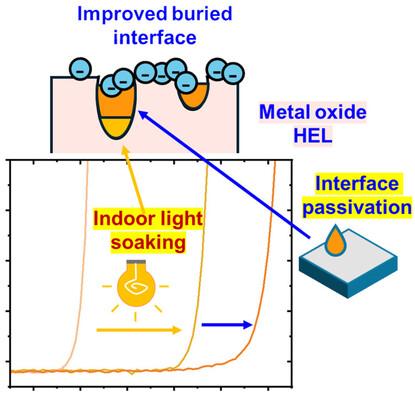用于卤化物过氧化物室内光伏的金属氧化物与有机半导体电荷提取层对比
IF 11.1
Q1 MATERIALS SCIENCE, MULTIDISCIPLINARY
引用次数: 0
摘要
在新兴的颠覆性技术物联网(IoT)中,卤化物包晶室内光伏(PV)极有希望为数十亿个微电子传感器自主供电。然而,各种不同类型的空穴萃取层(HELs)如何影响包晶体太阳能电池的室内光收集仍是一个未知数,这阻碍了室内包晶体光伏电池的材料选择和工业规模制造。本研究就卤化物包晶室内光伏电池埋藏界面 HEL 的司法选择提供了新的见解。这项研究首次揭示了基于金属氧化物传输层的光伏器件在室内光照效应下的有害和严重的光浸蚀效应,因此有必要对其进行界面钝化/工程处理,以提高其可靠性能。在太阳光照下,这并不是一个严格的标准。通过系统地研究电荷载流子动力学以及从黑暗、光浸透、层间钝化器件的测量序列,解耦了体缺陷和界面缺陷,揭示了从浅层到深层陷阱的渐进缺陷钝化过程。因此,本研究为克服金属氧化物 HEL 的有害效应并将其用于卤化物过氧化物室内光伏器件提出了一种有用的设计策略。本文章由计算机程序翻译,如有差异,请以英文原文为准。

Metal Oxide vs Organic Semiconductor Charge Extraction Layers for Halide Perovskite Indoor Photovoltaics
Halide perovskite indoor photovoltaics (PVs) are highly promising to autonomously power the billions of microelectronic sensors in the emerging and disruptive technology of the Internet of Things (IoT). However, how the wide range of different types of hole extraction layers (HELs) impacts the indoor light harvesting of perovskite solar cells is still elusive, which hinders the material selection and industrial-scale fabrication of indoor perovskite photovoltaics. In the present study, new insights are provided regarding the judicial selection of HELs at the buried interface of halide perovskite indoor photovoltaics. This study unravels the detrimental and severe light-soaking effect of metal oxide transport layer-based PV devices under the indoor lighting effect for the first time, which then necessitates the interface passivation/engineering for their reliant performance. This is not a stringent criterion under 1 sun illumination. By systematically investigating the charge carrier dynamics and sequence of measurements from dark, light-soaked, interlayer-passivated device, the bulk and interface defects are decoupled and reveal the gradual defect passivation from shallow to deep level traps. Thus, the present study puts forward a useful design strategy to overcome the deleterious effect of metal oxide HELs and employ them in halide perovskite indoor PVs.
求助全文
通过发布文献求助,成功后即可免费获取论文全文。
去求助
来源期刊
CiteScore
14.00
自引率
2.40%
发文量
0
期刊介绍:
Small Science is a premium multidisciplinary open access journal dedicated to publishing impactful research from all areas of nanoscience and nanotechnology. It features interdisciplinary original research and focused review articles on relevant topics. The journal covers design, characterization, mechanism, technology, and application of micro-/nanoscale structures and systems in various fields including physics, chemistry, materials science, engineering, environmental science, life science, biology, and medicine. It welcomes innovative interdisciplinary research and its readership includes professionals from academia and industry in fields such as chemistry, physics, materials science, biology, engineering, and environmental and analytical science. Small Science is indexed and abstracted in CAS, DOAJ, Clarivate Analytics, ProQuest Central, Publicly Available Content Database, Science Database, SCOPUS, and Web of Science.

 求助内容:
求助内容: 应助结果提醒方式:
应助结果提醒方式:


